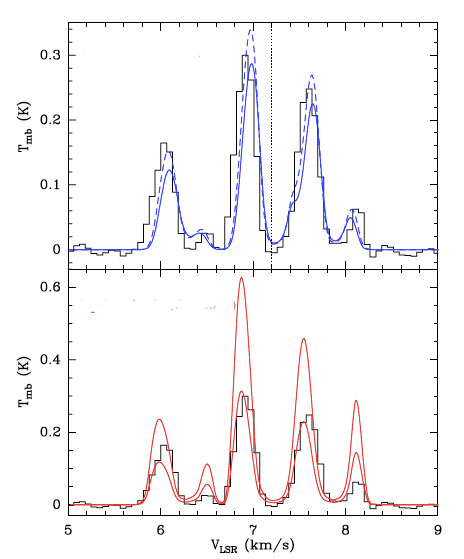
|
EPoS |
|
EPoS Contribution
|
|
Testing Theories of Star Formation
Eric Keto Harvard U, Cambridge, US | |
| The starless cores in regions of low-mass star formation such as Taurus and the Pipe nebula have served as observational examples for various hypotheses about the earliest phase of star formation, including the dynamics of the initial collapse or contraction of dense cores and the chemical evolution during collapse. Not all theories have survived the test. In this talk, we show how a model of slow, quasi-hydrostatic collapse with equilibrium grain-surface chemistry developed for observations of CO and N2H+ in L1544 successfully predicted the inverse P-Cygni profile of the H2O line and most recently the o-NH3(10-00) 572 GHz. Simulations of spectral line emission rule out other dynamical models such as the singular isothermal sphere, the Larson-Penston flow, and inflow from larger scales. In addition, a non-equilibrium or time dependent chemical model does not provide NH3 abundances as a function of radius as well as a simple model of nearly constant abundance. We will discuss the limitations of these results for more general theories of star formation. While L1544 is characteristic of low-mass cores in relatively quiet regions such as Taurus, most star formation, including low mass star formation, takes place in massive clusters such as Orion with a different environment. For example, chemical evolution in regions with sources of heat or shocks should not be limited to grain surface chemistry. Our results suggest that star formation may be bimodal, not in the traditional sense of low-mass versus high-mass stars but meaning that star-formation in very cold, quiet, low-mass regions may proceed differently than in massive clusters. This difference could clear up confusion resulting from the difficulty in applying the gravo-turbulent theory to star formation in Taurus versus its success applied elsewhere in the Galaxy. | |
 | |
| Caption: Figure: 572 GHz spectrum of NH3 from Herschel in black (Caselli et al 2017). Top: Simulated emission spectrum for the same model of quasi-hydrostatic collapse as used previously for CO, N2H+, and H2O spectra (Keto & Caselli 2008, 2010, 2012, 2014) and with a nearly constant abundance of NH3 with radius as suggested in Crapsi et al 2007. Solid and dashed blue lines made with ortho/para ratios of 0.7 and 1.0. Bottom: Same dynamical model but with abundances from the time-dependent chemical model of Sipila et al 2015. The red lines show the emission as predicted and divided by two. | |
| Collaborators: P. Caselli, MPE, DE |
Key publication
Suggested Session: Cores |